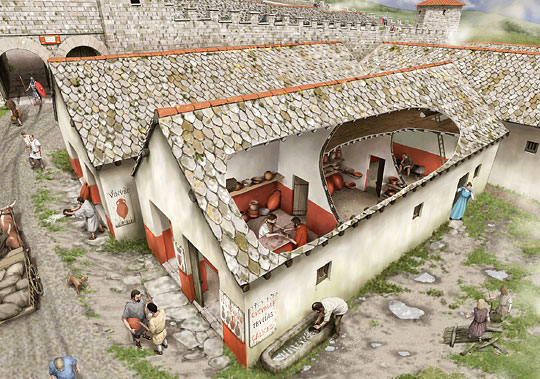Research on Housesteads Roman Fort
Excavations and discoveries in the 19th century defined the complete plan of the fort, and more recent excavations have presented a clearer chronology of many of the internal structures. The rich epigraphic record presents further scope for reinterpretation that is relevant to remains from across the Roman Empire.

Excavations
Apart from 'diggings' reported by 18th-century antiquaries, the earliest excavations were carried out by the Rev John Hodgson, in 1822 and 1830–33. Records of these works survive in publications and in his notebooks.[1]
For almost the rest of the 19th century, archaeological investigation was dominated by John Clayton, who bought the site in 1838 to form the core of his 'Roman Wall Estate'. A more systematic approach was undertaken in a single season by RC Bosanquet in 1898. His was the first academic record of the site, involving not just a careful description of his excavations but an account of earlier antiquarian enquiry.[2]
In the 1930s excavations directed by Eric Birley were concerned with the civilian settlement (vicus) outside the fort, the earliest extensive investigation of such a settlement. Of 27 known buildings only six were fully excavated and the remainder were traced only partially.
The most intensive programme of excavations was carried out in the north-west corner of the fort in 1974–81. For the first time the excavation was not limited to a particular building but included the adjacent roads and defences.
Research
Aerial photography and field survey of the many earthworks around the fort have allowed a detailed analysis of one of the most extensive archaeological landscapes in Britain, dating from the later prehistoric and Roman periods to modern times.
The excavation report of 2009 provides a detailed study of the 817 coins known from Housesteads, as well as of the ceramic and small finds.[3]
A distinctive type of pottery known as 'Housesteads Ware', made locally but using Frisian designs, appears to derive from the vicus and also from within the fort, implying that part of the vicus may have been associated with units of Frisians known to have been stationed here in the 3rd century. Recent research has re-examined their possible association with the eastern Netherlands.[4]
Current Gaps in Knowledge
- The bath-house on the far side of the Knag Burn is known only from limited investigation in the 19th century and may provide important evidence for the changing living conditions beside Hadrian's Wall.
- The Germanic or Frisian war bands known at Housesteads were non-Roman troops different from the standard garrisons of auxiliaries elsewhere along Hadrian's Wall. It is not yet understood how they related to the established garrisons or where they were housed.
- At a number of forts along the Wall there is good evidence for immediate post-Roman occupation; at Housesteads there are few traces of this other than an isolated building that may be a church.
- There is no evidence of post-Roman occupation of Housesteads before the 16th century, when the site is mentioned in written accounts. The evidence from field survey provides a complex sequence of agricultural activity which may indicate a longer history of occupation.[5]
READ MORE ABOUT HOUSESTEADS ROMAN FORT
Footnotes
1. J Hodgson, History of Northumberland, part 2, vol 3 (Newcastle upon Tyne, 1840), 185–95.
2. See review of previous research in J Crow, Housesteads: A Fort and Garrison on Hadrian's Wall, 2nd revised edn (Stroud, 2004).
3. RJ Brickstock and PJ Casey, 'The coins', in A Rushworth (ed), Housesteads Roman Fort, the Grandest Station: Excavation and Survey at Housesteads, 1954–95, by Charles Daniels, John Gillam, James Crow and Others, 2 vols, English Heritage Archaeological Report (Swindon, 2009), vol 2, 363–429.
4. I Jobey, 'Housesteads Ware – a Frisian tradition on Hadrian's Wall', Archaeologia Aeliana, 5th series, 7 (1979), 127–43; C Van Driel-Murray, 'Ethnic recruitment and military mobility', in , Limes XX: XXth International Congress of Roman Frontier Studies, Leon, Espana, Septiembre 2006, Anejos de Gladius 13, ed Á Morillo, N Hanel and E Martín (Madrid, 2009), 813–22.
5. J Crow, 'Tracing the Busy Gap rogues', International Journal of Historical Archaeology, 11 (2007), 322–36.